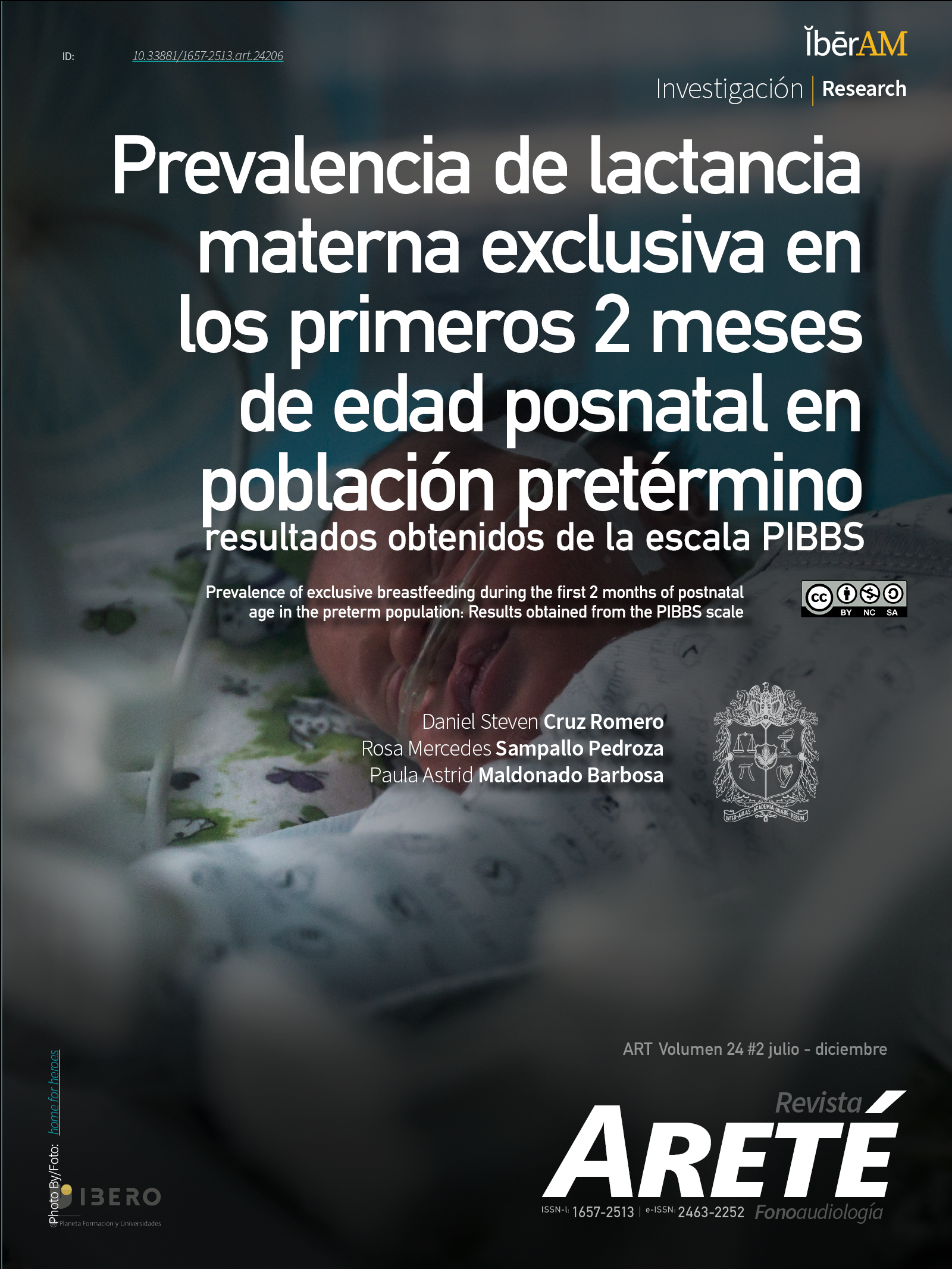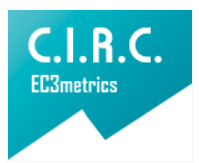Prevalence of exclusive breastfeeding during the first 2 months of postnatal age in the preterm population
Prevalencia de lactancia materna exclusiva en los primeros 2 meses de edad posnatal en población pretérmino Results obtained from the PIBBS scale
Main Article Content
The present study aims to correlate breastfeeding characteristics in preterm populations with the results obtained from the Preterm Infant Breastfeeding Behavior Scale (PIBBS) to determine the risk of exclusive breastfeeding cessation within the first two months of postnatal age. In the first stage of the study, the PIBBS scale is applied intramurally during the newborn’s speech-language evaluation. Subsequently, in the second stage, follow-up is conducted through telephone interviews to monitor the status of exclusive breastfeeding and relate it to the PIBBS score. Dyads scoring 8 points or less were characterized by a 100% cessation rate of exclusive breastfeeding (EBF). In contrast, scores ranging from 9 to 11 were associated with a 60% cessation rate of EBF at two months of age, placing these dyads at a moderate risk of EBF cessation. A relationship was identified between low PIBBS scores and speech-language diagnoses of immaturity and/or transition in the sucking-swallowing process. The PIBBS scale for the study of preterm populations demonstrates a high predictive factor regarding EBF failure in preterm newborns. A direct relationship was found between PIBBS score ranges and speech-language diagnoses.
Downloads
Publication Facts
Reviewer profiles N/A
Author statements
Indexed in
- Academic society
- Bogotá: Corporación Universitaria Iberoamericana
- Publisher
- Bogotá: Corporación Universitaria Iberoamericana
Article Details
Álvarez García, Y. (2024). Morbilidad del prematuro tardío [Trabajo de Fin de Grado]. Universidad de Valladoli.
Bisanalli, S. B. (2023). The beneficial effect of early and prolonged kangaroo mother care on long-term neuro-developmental outcomes in low birth neonates: A cohort study. Acta Paediatrica, 112(11), 2400-2407. doi:https://doi.org/10.1111/apa.16939 DOI: https://doi.org/10.1111/apa.16939
Borre Ortiz, Y. M. (2014). Lactancia materna exclusiva: ¿la conocen las madres realmente? 5(2), 723-730. doi:https://doi.org/10.15649/cuidarte.v5i2.84 DOI: https://doi.org/10.15649/cuidarte.v5i2.84
Boyce, J. O. (2019). ABM clinical protocol #17: Guidelines for breastfeeding infants with cleft lip, cleft palate, or cleft lip and palate—Revised 2019. Breastfeeding Medicine, 14(7), 437-444. doi:https://doi.org/10.1089/bfm.2019.29132.job DOI: https://doi.org/10.1089/bfm.2019.29132.job
Chen, D. Y. (2021). Effect of oral motor intervention on oral feeding in preterm infants: A systematic review and meta-analysis. American Journal of Speech-Language Pathology, 30(5), 2318-2328. doi:https://doi.org/10.1044/2021_AJSLP-20-00322 DOI: https://doi.org/10.1044/2021_AJSLP-20-00322
De la Hoz Cáceres, D. J.-G.-A.-M.-M. (2019). Revisión sistemática de las causas y tratamientos para las grietas en los pezones durante la lactancia materna. Entramado, 15(2), 218-228. doi:https://doi.org/10.18041/1900-3803/entramado.2.5739 DOI: https://doi.org/10.18041/1900-3803/entramado.2.5739
Eddrhourhi Laadimat, H. Z. (2021). Estímulo de la succión-deglución en prematuros: Unidad de cuidados intensivos neonatales. Revista Sanitaria de Investigación, 2(4). doi:https://dialnet.unirioja.es/servlet/articulo?codigo=8055579
Feenstra, M. M. (2018). Early breastfeeding problems: A mixed method study of mothers' experiences. Sexual & Reproductive Healthcare, 16, 167-172. doi:https://doi.org/10.1016/j.srhc.2018.04.003 DOI: https://doi.org/10.1016/j.srhc.2018.04.003
Foxman, B. D. (2002). Lactation mastitis: Occurrence and medical management among 946 breastfeeding women in the United States. American Journal of Epidemiology, 155(2), 103-114. doi:https://doi.org/10.1093/aje/155.2.103 DOI: https://doi.org/10.1093/aje/155.2.103
Gianni, M. L. (2019). Breastfeeding difficulties and risk for early breastfeeding cessation. Nutrients,, 2266. doi:https://doi.org/10.3390/nu11102266 DOI: https://doi.org/10.3390/nu11102266
Gomes, S. F. (2023). Tradução e adaptação para o português da Preterm Infant Breastfeeding Behaviour Scale. Acta Paulista de Enfermagem, 36(eAPE00171.). doi:https://doi.org/10.37689/acta-ape/2023AO00171 DOI: https://doi.org/10.37689/acta-ape/2023AO00171
Govoni, L. R. (2019). Breastfeeding pathologies: Analysis of prevalence, risk, and protective factors. cta Biomedica, 90(S4), 56-62. doi:https://doi.org/10.23750/abm.v90i4-S.8240
Habtewold, T. D. (2021). Sociodemographic factors predicting exclusive breastfeeding in Ethiopia: Evidence from a meta-analysis of studies conducted in the past 10 years. Maternal and Child Health Journal, 25(1), 72-94. doi:https://doi.org/10.1007/s10995-020-03059-2 DOI: https://doi.org/10.1007/s10995-020-03059-2
Jamehdar, M. N. (2022). Preterm Infant Breastfeeding Behavior Scale: A study for assessing the validity and feasibility. Iranian Journal of Neonatology, 13(3), 51-55. Obtenido de https://ijn.mums.ac.ir/article_20606.html
Li, L. W. (2021). Early skin contact combined with mother’s breastfeeding to shorten the process of premature infants ≤ 30 weeks of gestation to achieve full oral feeding: The study protocol of a randomized controlled trial. Trials, 22. doi:https://doi.org/10.1186/s13063-021-05605-x DOI: https://doi.org/10.1186/s13063-021-05605-x
Lober, A. D. (2020). Using the Preterm Infant Breastfeeding Behavior Scale (PIBBS) with late preterm infants. Clinical Lactation,, 11(3), 121-129. doi:https://doi.org/10.1891/CLINLACT-D-20-00001 DOI: https://doi.org/10.1891/CLINLACT-D-20-00001
Magenis, M. L. (2020). Down syndrome and breastfeeding: A systematic review. Journal of Intellectual Disabilities, 26(1), 244-263. doi:https://doi.org/10.1177/1744629520970078 DOI: https://doi.org/10.1177/1744629520970078
Ministerio de Salud y Protección Social, & UNICEF. (2021). Lineamiento para el manejo integrado de la desnutrición aguda moderada y severa en niños y niñas de 0 a 59 meses de edad (Resolución Nº 2350 de 2020). Obtenido de https://www.minsalud.gov.co/sites/rid/Lists/BibliotecaDigital/RIDE/VS/PP/SA/lineamiento-manejo-desnutricion-resolucion-2350.pdf
Nyqvist, K. H. (1996). Development of the Preterm Infant Breastfeeding Behavior Scale (PIBBS): A study of nurse-mother agreement. Journal of Human Lactation, 12(3), 207-219. doi:https://doi.org/10.1177/089033449601200318 DOI: https://doi.org/10.1177/089033449601200318
Oksuz, S. K. (2021). The effect of kangaroo mother care applied to the healthy newborns in the early postpartum period on breastfeeding: A randomized controlled trial. Journal of the Pakistan Medical Association., 71(9), 2124-2129. doi:https://doi.org/10.47391/JPMA.376 DOI: https://doi.org/10.47391/JPMA.376
Organización Panamericana de la Salud. (n.d). Lactancia materna y alimentación complementaria. Obtenido de https://www.paho.org/es/temas/lactancia-materna-alimentacion-complementaria
Pilatasig Tandalla, D. S. (2023). El abandono de la lactancia materna exclusiva y el uso de fórmulas lácteas. Revista Científica Latindex,, 8(1), 4858–4876. doi:https://doi.org/10.37811/cl_rcm.v8i1.9822 DOI: https://doi.org/10.37811/cl_rcm.v8i1.9822
Poma, N. M. (2023). Beneficios del dispositivo orotraqueal Leandro en el desarrollo del reflejo de succión y deglución en neonatos. Ciencia Latina Revista Científica Multidisciplinar, 7(6). doi:https://doi.org/10.37811/cl_rcm.v7i6.8991 DOI: https://doi.org/10.37811/cl_rcm.v7i6.8991
Prado Cuadros, T. S. (2018). Determinantes sociales del abandono de lactancia materna exclusiva en niños a término menores de 6 meses en un Centro de Salud en San Juan de Lurigancho, 2017. Revista Científica Ágora, 5(1), 6-12. doi:https://doi.org/10.21679/arc.v4i2.98 DOI: https://doi.org/10.21679/arc.v4i2.98
Queiroz, M. A. (2017). Fundamentos de fonoaudiología. Scribd. Buenos Aires: Editorial Medica Panamericana. Obtenido de Recuperado de https://es.scribd.com/document/353414293/Fundamentos-de-Fonoaudiologia-Queiroz-pdf
Rachmawati, E. Z. (2024). isk and predictive factors of oral feeding skills disorder in preterm infants: An observational study using flexible endoscopic evaluation of swallowing. Pediatrics and Neonatology. doi:https://doi.org/10.1016/j.pedneo.2024.04.010 DOI: https://doi.org/10.1016/j.pedneo.2024.04.010
Raol, N. S. (2018). Aspiration and dysphagia in the neonatal patient. Clinics in Perinatology, 45(4), 645-660. doi:https://doi.org/10.1016/j.clp.2018.07.005 DOI: https://doi.org/10.1016/j.clp.2018.07.005
Rendón Macías, M. E. (2011). Fisiología de la succión nutricia en recién nacidos y lactantes. Boletín Médico del Hospital Infantil de México, 68(4), 319-327.
Rendón Macías, M. E. (2011). Fisiología de la succión nutricia en recién nacidos y lactantes. Boletín Médico del Hospital Infantil de México, 68(4), 319-327. doi:https://ginecosofia.com/wp-content/uploads/2020/12/Anatomia-del-aparto-genital-femenino.pdf
Rigourd, V. N. (2015). Consejos para la lactancia materna. EMC - Tratado de Medicina, 19(1), 1-11. doi:https://doi.org/10.1016/S1636-5410(15)72806-0 DOI: https://doi.org/10.1016/S1636-5410(15)72806-0
Sakalidis, V. S. (2016). Suck-swallow-breathe dynamics in breastfed infants. Journal of Human Lactation, 32(2), 201-211. doi:https://doi.org/10.1177/0890334415601093 DOI: https://doi.org/10.1177/0890334415601093
Sampallo-Pedroza, R. M.-C.-S.-M. (2014). Description of oral-motor development from birth to six years of age. Revista de la Facultad de Medicina, 62(4), 593-604. doi:https://doi.org/10.15446/revfacmed.v62n4.45211 DOI: https://doi.org/10.15446/revfacmed.v62n4.45211
Schafer, R. &. (2015). Physiologic breastfeeding: A contemporary approach to breastfeeding initiation. Journal of Midwifery & Women's Health, 60(5), 546-553. doi:https://doi.org/10.1111/jmwh.12319 DOI: https://doi.org/10.1111/jmwh.12319
Thorley, V. (2019). Is breastfeeding 'normal'? Using the right language for breastfeeding. Midwifery,, 69, 39-44. doi:https://doi.org/10.1016/j.midw.2018.10.015 DOI: https://doi.org/10.1016/j.midw.2018.10.015
Von Salmuth, V. B. (2021). Maternal-focused interventions to improve infant growth and nutritional status in low-middle income countries: A systematic review of reviews. PLOS ONE,, 16(8), e0256188. doi:https://doi.org/10.1371/journal.pone.0256188 DOI: https://doi.org/10.1371/journal.pone.0256188

















